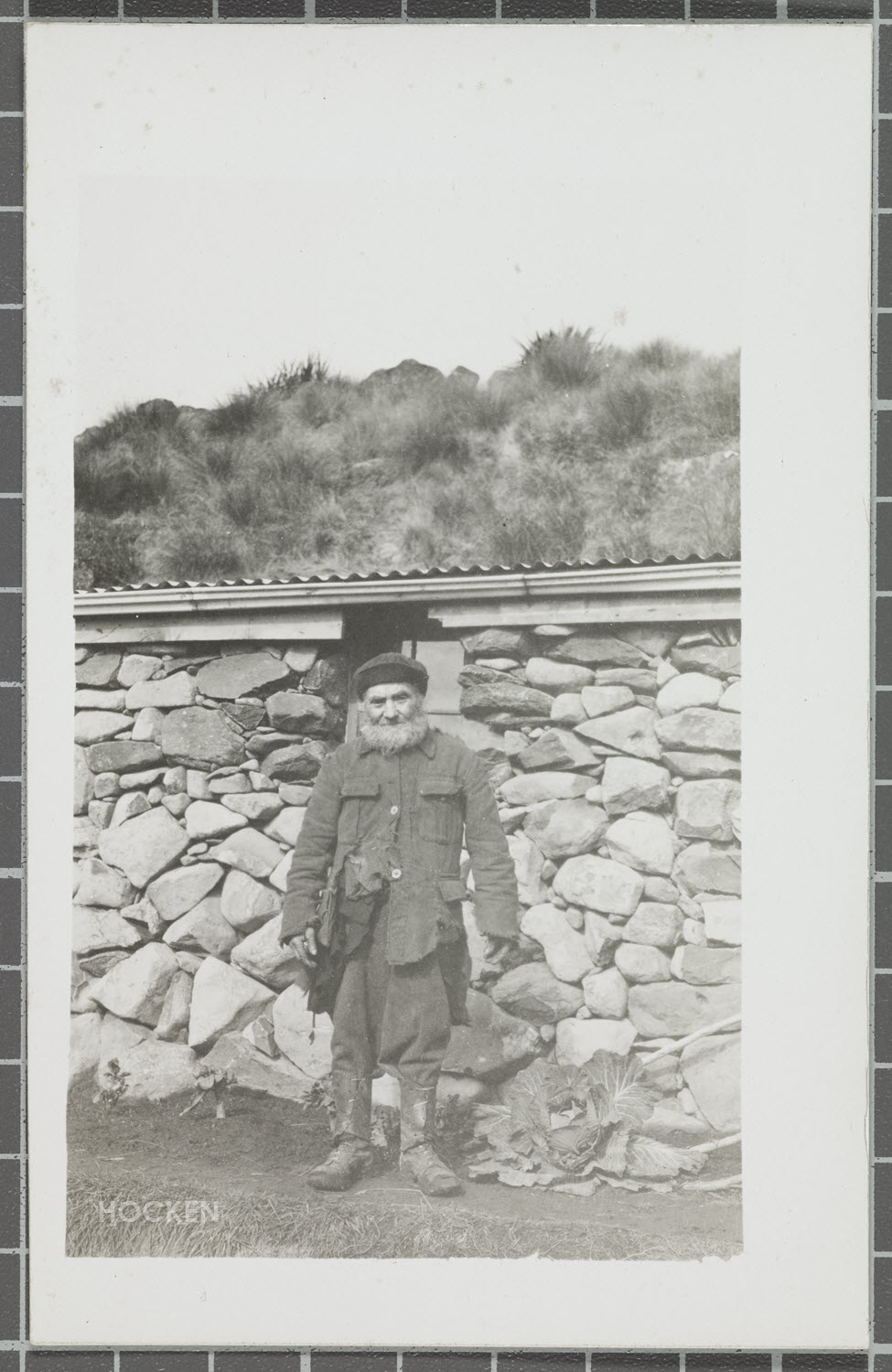
Ben Rudd, Flagstaff (1924). Rudd outside his stone cottage. Hocken Collections Uare Taoka o Hākena, P1997-155/04-0738-001.
Post researched and written by Jennie Henderson, Hocken Collections Assistant.
Many of us may be feeling a bit hermit-like during New Zealand’s Covid-19 lockdown, but we are not Dunedin’s first hermits! 100 years ago, Dunedin resident Ben Rudd earned the nickname ‘The Hermit of Flagstaff’ with his reclusive habits.
Benjamin Rudd (1854-1930) was born in England, and came to Dunedin after completing a gardening apprenticeship. He worked in Dunedin as a gardener for many years, and lived on two farm properties on the slopes of Flagstaff. When he wasn’t working in town, and after his retirement from gardening, Rudd poured all his efforts into his farm – laboriously building stone fences and his hut by hand, developing extensive gardens, and lovingly caring for his animals.[1]
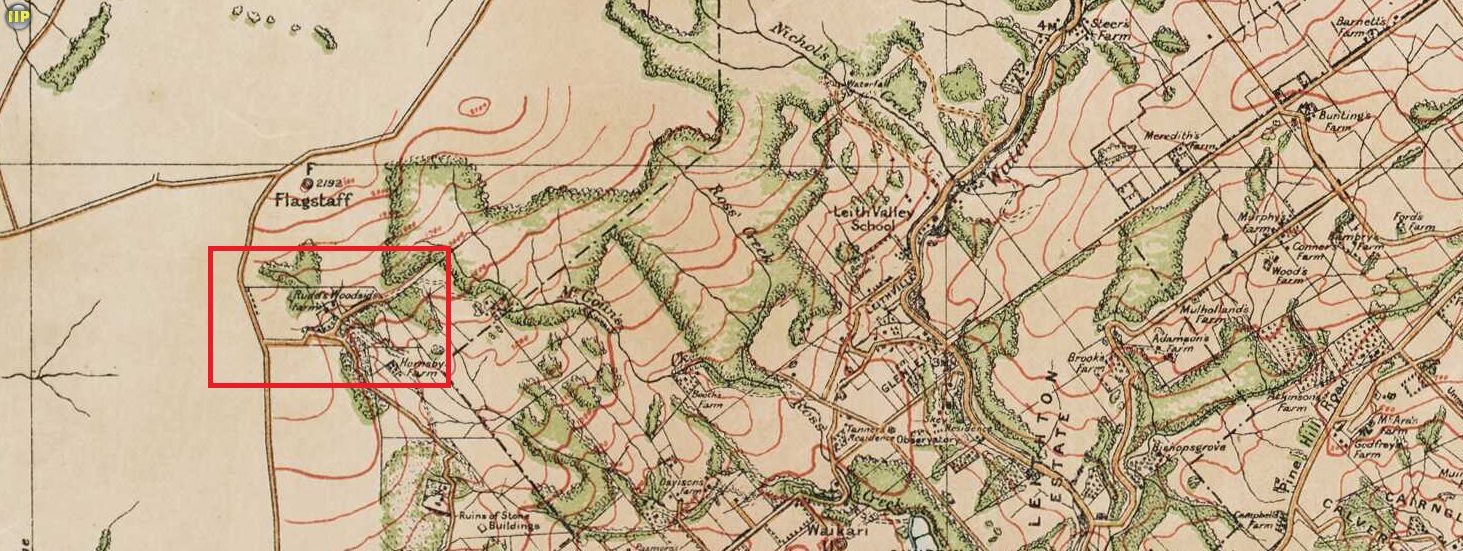
In this section of W.T. Neill’s 1922 map, Ben Rudd’s first farm, Woodside, can be seen. Rudd sold this farm and moved back into Dunedin to work as a gardener for Peter Dawson in 1919, but returned to a new property on the northern slopes of Flagstaff after 18 months. Topographical map showing Dunedin and vicinity / from surveys by W.T. Neill, district surveyor, [Wellington]: N Z Lands and Survey. Sourced from LINZ. Crown Copyright reserved.
Rudd’s disputes with his tormentors often made it to court, and a colourful picture of these surprisingly violent encounters can be drawn from the newspaper reports. In 1886, Rudd was committed for trial for shooting at John Waldie with intent to kill.[2] It was reported that Waldie and a friend had ridden past Rudd’s property, and said to him “Good morning, Uncle Ben. You’re working hard”. Rudd’s response was to throw stones at them, and then to shoot at them, hitting Waldie and his horse. Rudd’s lawyer argued that the men had teased Rudd many times, and that he had only intended to scare them with the gun. At his trial, the jury found Rudd not guilty.[3]
In 1889, Rudd was found to have assaulted Susan Hornsby. When Rudd found Hornsby and her sister out walking on his land, unknowingly trespassing, he hit her on the face, grabbed her hair, and kicked her. Rudd maintained that he did not touch her, but only waved his hand near Hornsby to shoo her off his land. The court considered the charge to be proven, and Rudd was fined.[4]
In 1894, Rudd was in court again for assaulting a trespasser with a hay-fork. The attending doctor reported that Edward Thomas’s skull was fractured by Rudd’s blow. He was fined £22 and costs.[5]
In 1902, during another assault trial, Rudd’s defence counsel commented on the extent of the trespassing which so infuriated Rudd:
“…practically speaking the whole of the top of Flagstaff was Rudd’s property, part of it freehold and part leased. On holidays, Saturdays, Sundays, and Wednesdays a number of persons were frequently walking through and trespassing on his ground… Considerable damage was often done to his fence and any crop he might have.”[6]
This frustrated a local, who wrote to the newspaper in reply:
“… I have heard of Rudd and his propensities, and have always carefully avoided the enclosed selection on which he lives. Outside it there are no fences; there is nothing whatever between high roads and mountain top to suggest that the land is other than common. Am I, nevertheless, liable to Rudd’s pleasant attentions? … It would seem…so long as Ben doesn’t kick us, he may knock us about as he pleases… perhaps, he’ll strike a snag next time.”[7]
The judge presiding over the case acknowledged the problem of Rudd’s behaviour: “… it was a difficult thing to know what to do with this man, whether he should not be punished or sent to some place where he could be controlled”.[8]
It was a challenging situation for all involved. Rudd, hugely sensitive to trespass (and violent towards the trespassers) but also the target of abuse, faced frequent incursions onto his property. One such walker actually posted an apology in the paper in 1904.[9] Inspired by this apology, a member of the public, Mr Baylie (actually Rudd’s uncle), wrote to the editor describing some of the offences against Rudd and his property, including garden implements and firewood being stolen, and on one occasion, a large stone being loosed and rolled down the hill, breaking his fences.[10] In 1907, Rudd brought trespass and assault charges against a picnicker. At the trial, Rudd’s lawyer spoke of the magnitude of the issue: “The number of trespassers averaged 100 a week. In the course of one year he had counted 16,000 trespassers on his property. He had intended to rear native birds, native trees, and game on his property, but trespassers had defeated his objects”.[11] Conversely, the lawyer for the defendant stated that Rudd “…had been a source of terror for many years to people who desired to visit Flagstaff. He had really become a menace to the safety of the public”.[12] The newspaper reports on Rudd reveal that his situation somewhat polarised the town. Many seemed to empathise with the old man who just wanted to be left alone, and others found his actions, and his desire to limit access to Flagstaff, reprehensible.[13]
While Rudd clearly had faith in the court system, he also spoke for himself by composing poems. In 1904, a photo of Rudd and his horse Kit was published with the title ‘A well-known local celebrity’. It was accompanied by a poem, by Rudd, about Kit.[14] In this poem, Rudd refers to himself as ‘a jovial soul’ who defies trouble. He mentions ‘The folk [who] kindly greet us’ as he and Kit headed into town for supplies; this was a vastly different picture of his experiences than that painted by his appearances in the court news! Rudd was also concerned about the ability of the working man to earn an honest living on the land, as expressed in this poem to local representative Donald Reid, and in this poem about taxes republished after his death.[15] Rudd clearly felt the pressure of changing times encroaching on his desire for a simple farmer’s life.
Perhaps surprisingly, one group of walkers found favour with Rudd and became friends with the old man. In 1923, members of the newly formed Otago Tramping Club (now the Otago Tramping and Mountaineering Club) encountered Rudd while walking in the area. This initial meeting is recounted in the first issue of the Club’s journal, Outdoors, in 1934.[16] In spite of Rudd’s reputation, he and the Club came to an agreement that he would cut a track through the scrub for the club members to access Whare Flat, for which he was paid £5.[17] Club members regularly visited Rudd on their walks through the area.[18]
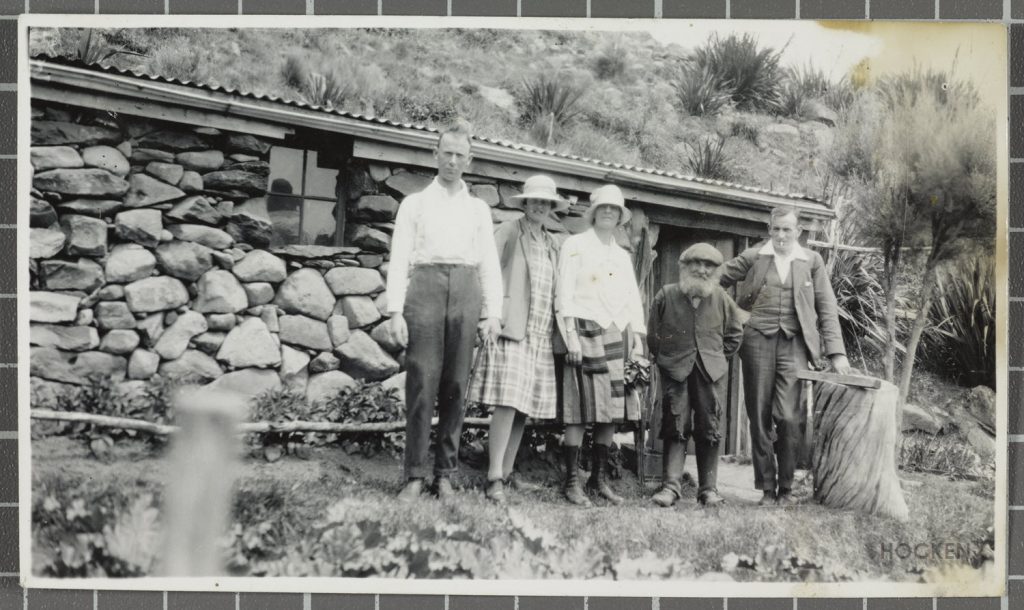
Ben Rudd with visitors (1923-1925). A photo of Rudd, possibly with members of the Otago Tramping Club. Hocken Collections Uare Taoka o Hākena, P1998-103.
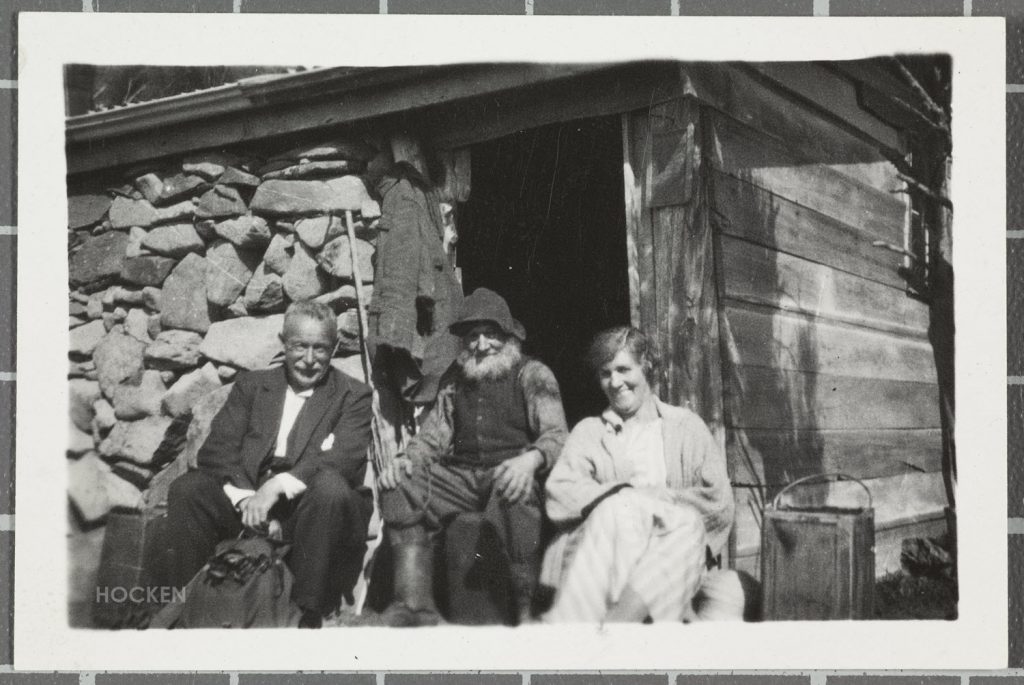
O. Balk, Ben Rudd and Mrs Lessing (1924). Balk was the first president of the Otago Tramping Club. Hocken Collections Uare Taoka o Hākena, P1997-155/04-0738-002.
In February 1930, two of Rudd’s visitors found him ill in his hut.[19] It seemed that he may have been ill for some time, but was unable to go for help. He was taken to hospital, but died there on March 2. Obituaries and reminiscences were published in the paper for some time after his death.[20]
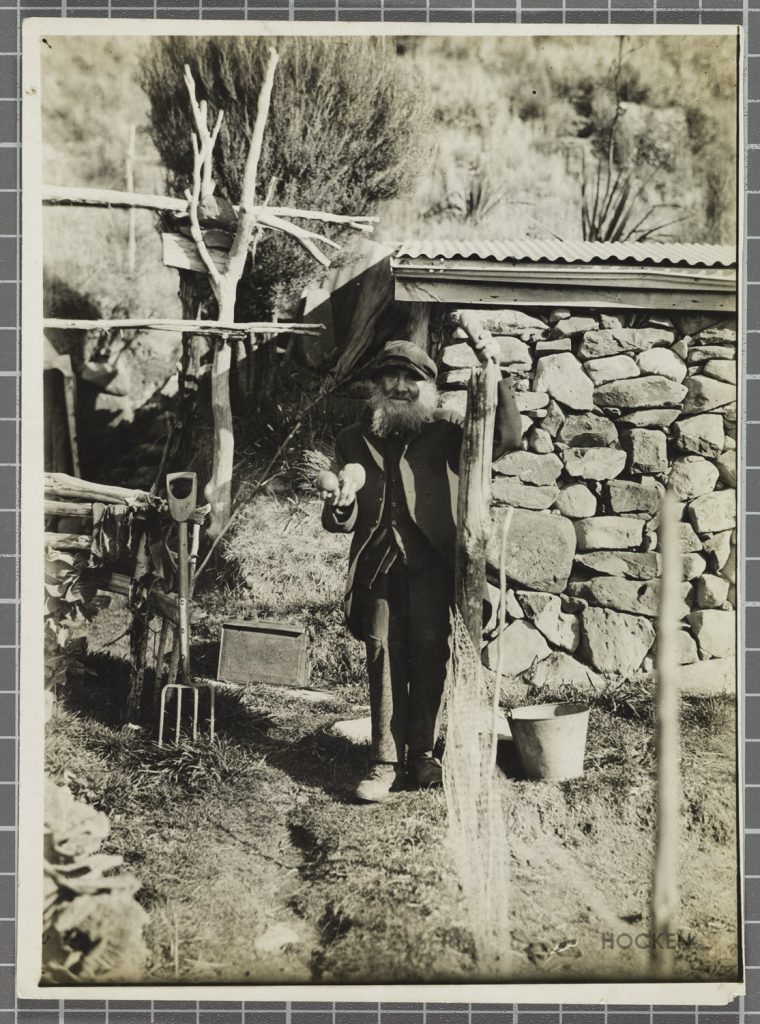
Ben Rudd (c.1920s). Ben Rudd in his garden. Hocken Collections Uare Taoka o Hākena, P2002-045-001.
Rudd lived on in the common memory of Dunedin residents, and in landmarks. Rudd Rd ran (and runs today) off Wakari Rd and up towards to site of Ben’s first farm, Woodside. In 1934, a correspondent to the Evening Star suggested renaming Flagstaff ‘Rudd Hill’.[21] In 1946, the OTC purchased Rudd’s second farm on the northern slopes of Flagstaff, and runs it as a trust to this day. They organise regular expeditions for weed control and native tree planting, and there is a shelter built near the former site of Ben’s hut. Much of the information available about Ben Rudd has been gathered together by the OTMC in relation to the Ben Rudd Management Trust, and is published on the OTMC website.
Hocken holds archives (ARC-0338), publications, and ephemera relating to the OTMC, with special reference to Ben Rudd’s property, including: Friends of Ben Rudd’s newsletter, programmes of the OTMC which include details of working bees on the property, the OTMC journal Outdoors, Friends of Ben Rudd membership certificate, Annual reports of the OTMC (including the report from 1947 which first refers to the purchase of Ben Rudd’s land), and plans for a shelter to replace Ben Rudd’s hut.
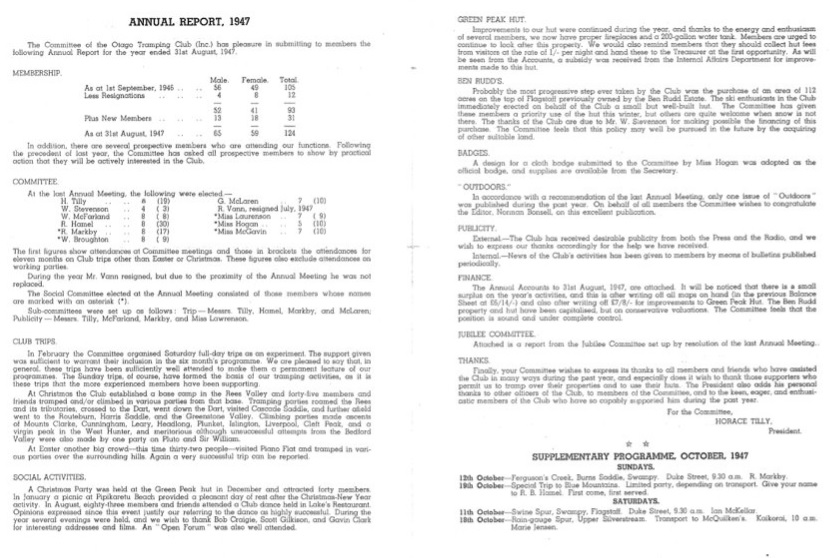
This Otago Tramping Club annual report (1947) mentions the purchase of Ben Rudd’s former farm and the erection of a hut.
The Hocken Photographs collection holds a number of photographs of Rudd, such as the examples below.
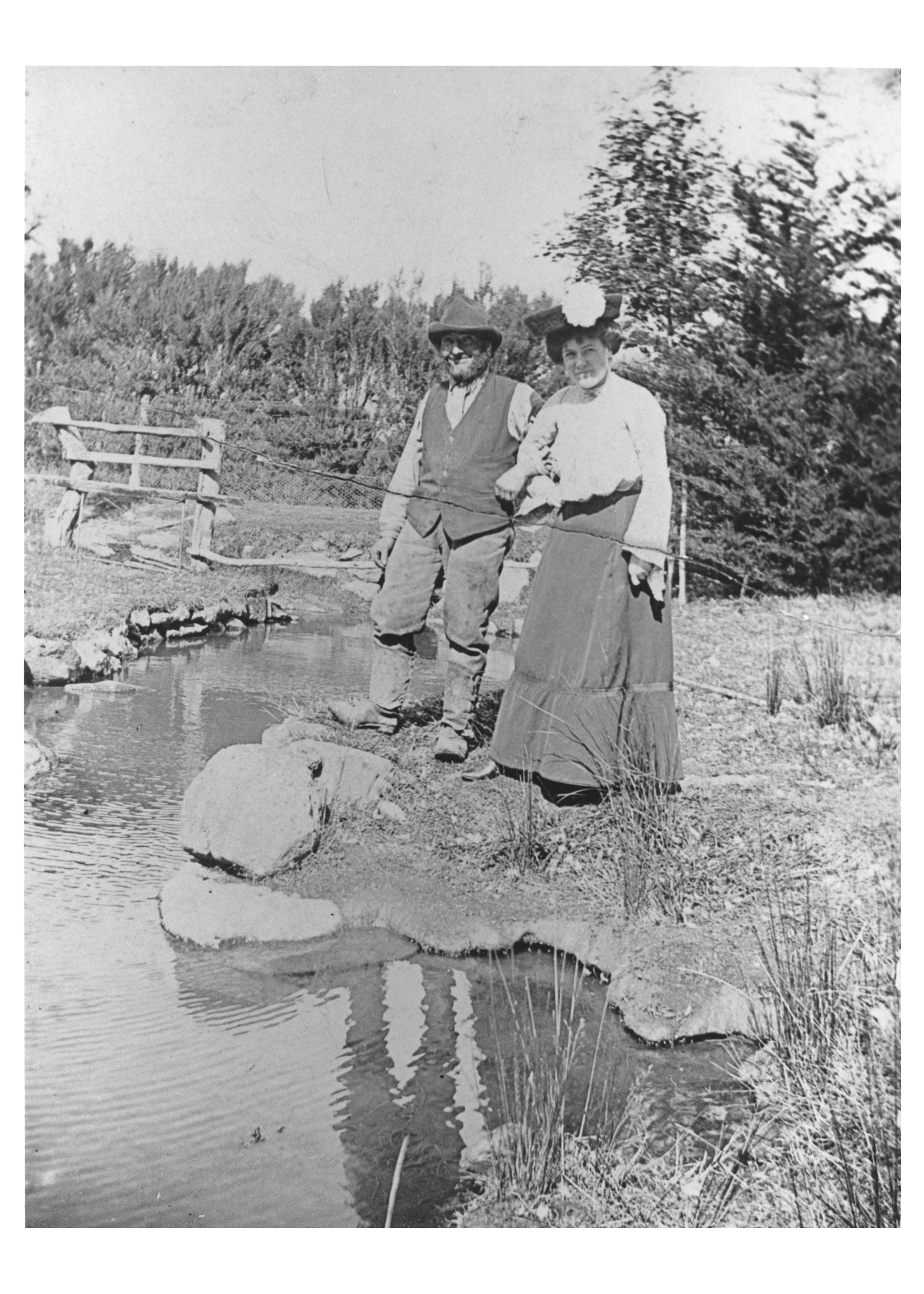
Ben Rudd with Maggie Watt (c.1900). Hocken Collections Uare Taoka o Hākena, Box-027 PORT 1303.
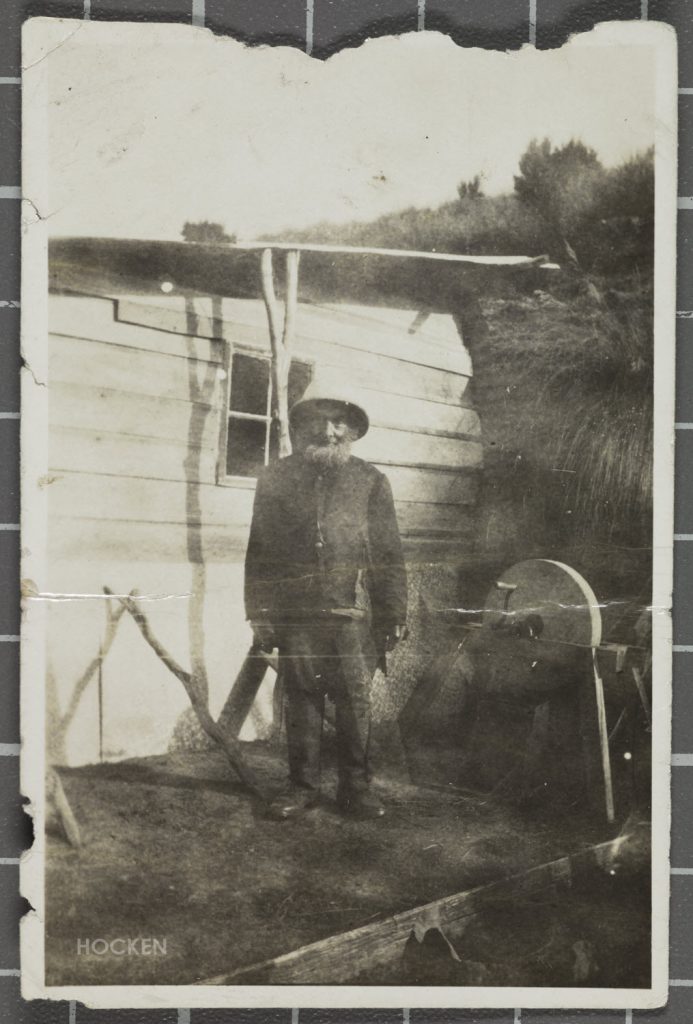
Hermit of Flagstaff, Ben Rudd (c.1920s). Hocken Collections Uare Taoka o Hākena, P1999-033-001.
As well as writing poems himself, Ben Rudd provided inspiration for others. Charles Brasch, the famous Dunedin poet, wrote a poem ‘Ben Rudd’. It was first published in Landfall in 1957, and revised for Ambulando (1964). The Aotearoa NZ Poetry Sound Archive has a recording of Brasch reading this poem on New Zealand poets read their work (1974). Hocken also holds a copy on LP. You can listen here at the poetryarchive.org.
… No one crossed his door,
No one crossed his path
For fear
Of sudden threat or oath.
And yet his single care
Was to keep at bay
All who might interfere
Coming to pry – …[22]
Dunedin author Geoff Weston also wrote a poem about Rudd, published more recently in 2005.
…“I’ve been once to town!” He’d’ scowl; “And that’s enough-for me.”
“I found these boots; these bloody boots;
And they’ve never been right.
They make me itch; and they make me scratch; and they make me pee;
And they’re always bloody tight!”…[23]
Rudd was buried in Anderson’s Bay cemetery with his uncle John Wycliffe Baylie. He is remembered for his eccentricity, his volatile temper, his passion for nature and animals, and through his land, managed in his name to this day.
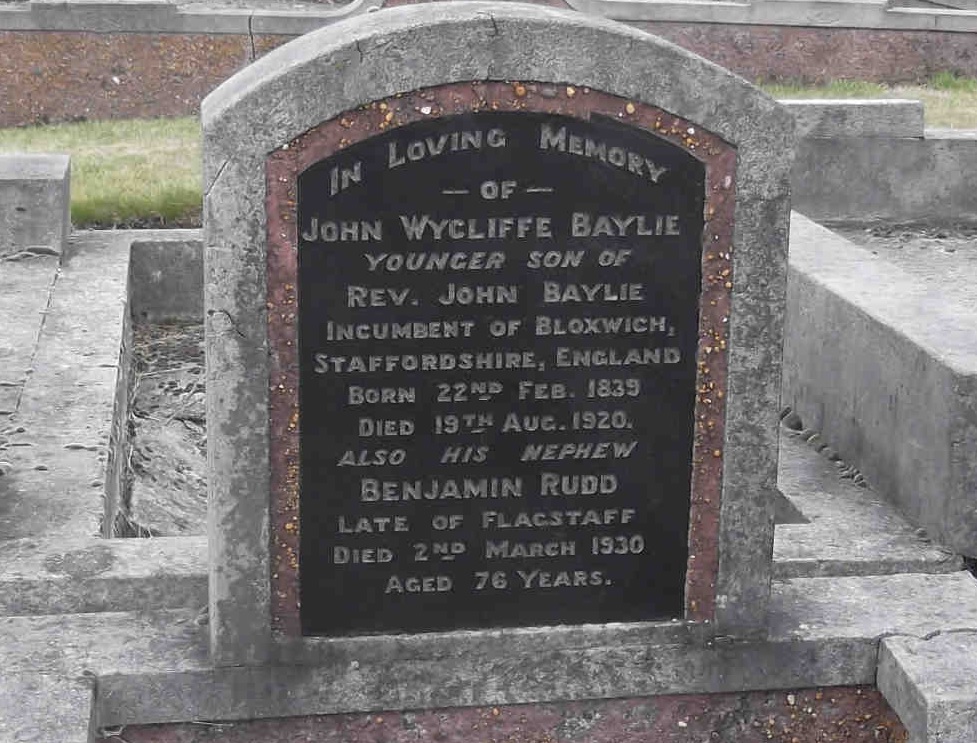
Ben Rudd’s headstone in Anderson’s Bay cemetery, Dunedin.
[1] For a wonderful image of Rudd standing by his stone walls, see Otago Witness, 3 May 1911, Page 46 (Supplement). Jane Thomson, ed., Southern People: a dictionary of Otago Southland biography, Longacre Press, Dunedin, New Zealand, 1984 describes Rudd’s method of levering individual stones into place from a sack tied around his waist like an apron.
[2] Tuapeka Times, 9 January 1886, Page 2.
[3] Evening Star, 12 April 1886, Page 2.
[4] Evening Star, 5 April 1889, Page 2.
[5] Evening Star, 23 June 1894, Page 1 (Supplement).
[6] Evening Star, 14 February 1902, Page 3.
[7] Otago Daily Times, 15 February 1902, Page 11.
[8] Evening Star, 14 February 1902, Page 3.
[9] Evening Star, 2 November 1904, Page 5.
[10] Evening Star, 7 December 1904, Page 8.
[11] Evening Star, 9 December 1907, Page 4. There is a full description of the trial, including the injuries to Rudd and the defendant, Edward Fountain, here.
[12] Evening Star, 9 December 1907, Page 4.
[13] In Evening Star, 24 June 1905, Page 9, there is a long and touching interview with ‘the strange man of the hill’ which illustrates how many Dunedin locals felt a connection to Rudd. Compare this to the unfavourable remarks in ‘Dunedin letter’, Tuapeka Times, 18 December 1907, Page 3.
[14] Otago Witness, 30 November 1904, Page 74.
[15] The editorial piece which includes to poem to Reid also mentions the death of Rudd’s horse, at his own hand, when she collapsed with old age, Evening Star, 17 March 1906, Page 2. ‘Taxes’, Evening Star, 4 March 1930, Page 7.
[16] Held at Hocken Collections.
[17] Evening Star, 12 October 1923, Page 6.
[18] For example, see Otago Daily Times, 7 October 1926, Page 4.
[19] Otago Daily Times, 24 February 1930, Page 7.
[20] ‘Obituary’, Evening Star, 3 March 1930, Page 9. For some heartfelt reminiscences, see ‘From a suburban balcony’, Evening Star, 22 March 1930, Page 2; ‘Ben Rudd, the Flagstaff Hermit’,
Otago Daily Times, 29 March 1930, Page 19.
[21] Evening Star, 27 October 1934, Page 2.
[22] Charles Brasch, ‘Ben Rudd’ from Alan Roddick, ed., Collected poems, Oxford University Press, New Zealand, 1984.
[23] Geoff Weston, ‘I knew Ben Rudd’ in Knight, et al., Glowing embers, Dunedin, 2005.


Hello Anna
Thank you for this marvellous blog. I have benefited greatly from your labours!
Kind regards
Richard, (normally the ‘editor’ of the irregular newsletter of the Friends of Ben Rudd’s; and an unrelenting(!) Trustee of the Ben Rudd’s Management Trust)
Thanks Richard, I’ll pass your comment onto the author of the article, Jennie Henderson. I’m only the editor!